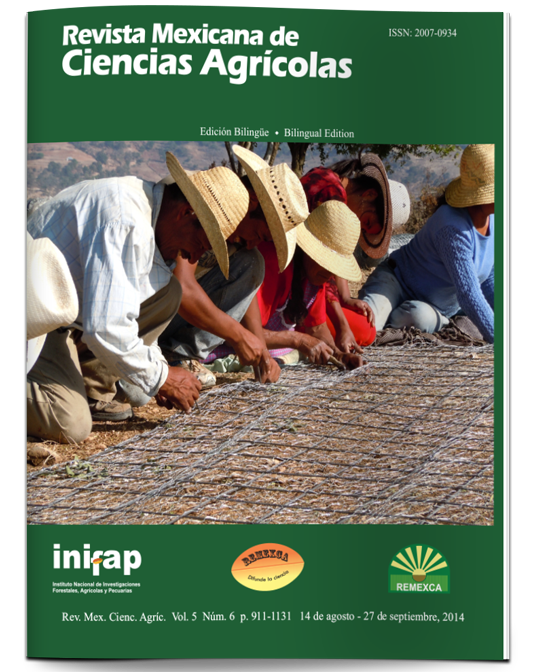Determination of runoff in Huixtla, Chiapas basin, by the Nc method and using GIS, TAM and NB10
DOI:
https://doi.org/10.29312/remexca.v5i6.883Keywords:
runoff, curve number, coastal basins, number base 10Abstract
It was determined the runoff volume Ve for 53 sub basins of Huixtla Basin from Mexican Coasts of Chiapas, corresponding to precipitation of Tropical Storm Stan occurred from October 01 to 06 2009, using the distributed and added models, using the concept Nc curve number and retention parameter Sr defined by the United States Department of Agriculture (USDA), and applying map algebra techniques (TAM), Geographic Information Systems (GIS) and the algorithm number base 10 (NB10); which is proposed to associate the characteristics that depend on Nc; for this was generated a table with present land use in the basin, defining the NB10 from 1 000 to 13 000, another for the types of hydrologic conditions to which are associated the NB10 multiples of 100 (100 for good, 200 for Regular and 300 for poor) and a third for hydrological groups that were assigned NB10 multiples of 10 (10 for group A, 20 for B, 30 for C and 40 for D). From the results of the runoff volume for sub-basins (Vec), by the distributed model and the aggregate model, it is observed that the differences between the two methods are minimal, on the order 1.07% of the average; the runoff volume (Ve) for the Huixtla Basin, calculated by the distributed model was 301 229 025 m3 (equivalent to Le= 0.847 m) and the aggregate model of 304 115 519 m3 (corresponding to Le= 0.856 m), which implies a difference of 0.97% and means that both models, used with GIS, TAM and NB10 techniques, practically provides the same results, so it can be used either one or the other interchangeably.
Downloads
Downloads
Published
How to Cite
Issue
Section
License
The authors who publish in Revista Mexicana de Ciencias Agrícolas accept the following conditions:
In accordance with copyright laws, Revista Mexicana de Ciencias Agrícolas recognizes and respects the authors’ moral right and ownership of property rights which will be transferred to the journal for dissemination in open access. Invariably, all the authors have to sign a letter of transfer of property rights and of originality of the article to Instituto Nacional de Investigaciones Forestales, Agrícolas y Pecuarias (INIFAP) [National Institute of Forestry, Agricultural and Livestock Research]. The author(s) must pay a fee for the reception of articles before proceeding to editorial review.
All the texts published by Revista Mexicana de Ciencias Agrícolas —with no exception— are distributed under a Creative Commons License Attribution-NonCommercial 4.0 International (CC BY-NC 4.0), which allows third parties to use the publication as long as the work’s authorship and its first publication in this journal are mentioned.
The author(s) can enter into independent and additional contractual agreements for the nonexclusive distribution of the version of the article published in Revista Mexicana de Ciencias Agrícolas (for example include it into an institutional repository or publish it in a book) as long as it is clearly and explicitly indicated that the work was published for the first time in Revista Mexicana de Ciencias Agrícolas.
For all the above, the authors shall send the Letter-transfer of Property Rights for the first publication duly filled in and signed by the author(s). This form must be sent as a PDF file to: revista_atm@yahoo.com.mx; cienciasagricola@inifap.gob.mx; remexca2017@gmail.
This work is licensed under a Creative Commons Attribution-Noncommercial 4.0 International license.



